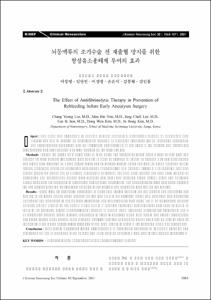KUMEL Repository
1. Journal Papers (연구논문)
1. School of Medicine (의과대학)
Dept. of Neurosurgery (신경외과학)
뇌동맥류의 조기수술 전 재출혈 방지를 위한 항섬유소용해제 투여의 효과
- Keimyung Author(s)
- Lee, Chang Young; Yim, Man Bin; Lee, Jang Chull; Son, Eun Ik; Kim, Dong Won; Kim, In Hong
- Department
- Dept. of Neurosurgery (신경외과학)
- Journal Title
- 대한신경외과학회지
- Issued Date
- 2001
- Volume
- 30
- Issue
- 9
- Abstract
- Object:This study was conducted to evaluate whether short-term intravenous infusion of tranexamic acid(AMCA) was able to improve the management outcome by preventing rebleeding without increasing vasospasm and hydrocephalus associated with the long-term administration of this agent in the patients with aneurysmal subarachnoid hemorrhage(SAH) who were planned for the early surgery.
Methods:During the period from June, 1996 to May, 1998, 137 patients admitted within 3 days of their SAH and planned for early surgical intervention were subject to study population. Of these, 60 patients who had been treated with AMCA were classified as AMCA treated group and 77 patients without AMCA treatment as AMCA untreated group. Initially, prognostic factors for rebleeding, vasospasm, hydrocephalus and outcome following SAH including age, sex, clinical grade, CT grade, site of ruptured aneurysms, admission day after SAH, surgery day after SAH, number of aneurysms and hypertension history, were analyzed and compared between AMCA treated group and untreated group. Secondly, the incidence of rebleeding, symptomatic vasospasm and hydrocephalus were compared between the two groups. Also, the management outcome of the patients was compared between the two groups.
Results:There were no significant differences in prognostic factors between the two groups. The rebleeding rate was 0% in the AMCA treated group whereas the rate was 7.8% in the untreated group. This difference was statistically significant. The incidences of symptomatic vasospasm and hydrocephalus were found not to be significantly different between the two groups. Of the treated group, 31.7% of patients developed hydrocephalus compared to 32.5% of those at the untreated group. Fourteen(23.3%) patients in treated group developed symptomatic vasospasm and 6 of them(10%) suffered stroke whereas incidences of these in untreated group were 25.9% and 11.7%, respectively. The AMCA treated group showed more favorable outcome than that of untreated group. There was no case of death by rebleeding in the AMCA treated group while one of the main causes of death in the untreated group was rebleeding.
Conclusion:Short-term high-dose AMCA administration is considered beneficial in improving outcome and diminishing the risk of rebleeding in the patients who suffer from an aneurysmal SAH prior to early surgical intervention.
파열된 뇌동맥류의 조기수술이 계획된 환자에서 수술전까지 단기간에 걸친 항섬유소용해제 투여의 효과를 알아보기 위해 뇌동맥류성 지주막하출혈 환자 137례에 대하여 60례를 AMCA 투여군으로, 77례를 비 투여군으로 분류하여 재출혈, 증상적 혈관연축, 뇌수두증의 발생빈도 및 전체
적인 치료성적을 비교, 분석하였다. 재출혈의 발생빈도는 AMCA 비 투여군에 비해 투여군에서 통계학적으로 유의하게 낮게 나타났고 AMCA의 장기투여에서 증가를 보인 증상적 혈관연축과 뇌수두증의 발생빈도는 양군에서 유의한 차이를 보이지 않았으며 전체적인 치료성적은 AMCA 투여군에서 비 투여군에 비해 보다 양호한 결과를 보였다. 따라서 조기수술이 계획된 뇌동맥류성 지주막하출혈 환자에서 AMCA의 단기간 투여는 재출혈율을 감소시켜 전체적인 치료결과를 향상시키는데 도움이 될 것으로 생각된다.
- Alternative Title
- The Effect of Antifibrinolytic Therapy in Prevention of Rebleeding before Early Aneurysm Surgery
- Publisher
- School of Medicine
- Citation
- 이창영 et al. (2001). 뇌동맥류의 조기수술 전 재출혈 방지를 위한 항섬유소용해제 투여의 효과. 대한신경외과학회지, 30(9), 1065–1071.
- Type
- Article
- ISSN
- 1225-8245
- Appears in Collections:
- 1. School of Medicine (의과대학) > Dept. of Neurosurgery (신경외과학)
- 파일 목록
-
-
Download
 oak-bbb-1969.pdf
기타 데이터 / 334.24 kB / Adobe PDF
oak-bbb-1969.pdf
기타 데이터 / 334.24 kB / Adobe PDF
-
Items in Repository are protected by copyright, with all rights reserved, unless otherwise indicated.